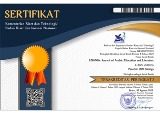Al-Musykilāt aṣ-Ṣauṭiyah ladā ad-Dāris bigair al-‘Arabiyyah ‘inda Ta’allum Mahārah at-Tahadduṡ
Abstract
Keywords
Full Text:
PDFReferences
البرازي، مجد محمد الباكير. مشكلات اللغة العربية المعاصرة. الأردن: مكتبة الرسالة الحديثة، 1989.
بشر، كمال. علم الأصوات. 2000.
بشر،كمال. فن الكلام، القاهرة: دار غریب، 2003.
جردات ونسرين. تدريس العربية كلغة وسيطة. 2015.
الحديدي، علي. مشكلة تعليم اللغة العربية لغير العرب. القاهرة: دار الكتاب العربي للطباعة والنشر، 1967.
حفيف، زاهر مرهون. مناهج وكتب تعليم اللغة العربية للناطقين بغيرها. القاهرة: دون السنة.
حنا، سامي عیاد وكریم زكي حسام الدین. معجم اللسانيات الحديثة. لبنان: 1997.
حنا، شرف الدین الراجحي وسامي عیاد. مبادئ علم اللسانیات. القاهرة: دار المعرفة الجامعیة، 2003.
داود، محمد محمد. الصوائت والمعنى في العربیة.القاهر:، دار غریب،2001.
الذياب، أحمد. المشاكل التي تواجه الأتراك في تعليم اللغة العربية والمقترحات. رسالة ماجستير.جامعة غازي، أنقرة، 2013.
الراحي، عبده. النحو العربي الحديث. بيروت: 1981.
صالح، عبد الرحمن الحاج. محاضرات بمركز البحوث العلمیة والتقنیة لترقیة اللغة العربیة. الجزائر: 2004.
عمر، أحمد مختار. دراسة الصوت اللغوي. 2004.
عمر، أحمد مختار. دراسة الصوت اللغوي. القاهرة: عالم الكتب، 1997.
قدور، أحمد محمد. مبادئ اللسانيات. القاهرة: دار النهضة، 1996.
ماسيري، ديكوري وسمية دفع الله. المشكلات الصوتية. 2012.
الناقة، محمود كامل. المدخل في تدريس النحو. الرياض، 2011.
Al-Batal, M. (1995). Issues in the Teaching of the Productive Skills in Arabic. In M.
Al-Batal, M. (Ed.). The teaching of Arabic as a foreign language: Issues and directions (pp.1-11). Provo, UT: American Association of Teachers of Arabic.
Alghazo, S. (2015). The Role of Curriculum Design and Teaching Materials in Pronunciation Learning. Research in Language.
Brooks, N.H. (1964). Language and Language Learning: Theory and Practice. 2nd edn. New York: Harcourt Brace.
Brumfit, C, J. (1999). Communicative methodology in language teaching (9th ed). Cambridge university Press.
Cook-Sather, A. (2002). Authorizing Students’ Perspectives: Toward Trust, Dialogue, and Change In Education. Educational Researcher.
Council of Europe (2001). The Common European Framework of reference for Languages: Learning, Teaching, Assessment. Cambridge: Cambridge University Press.
D. Aguis, (Ed.). Diglossic tension: Teaching Arabic for communication (pp.42- 45). Beaconsfield Papers. Leeds, England: Folia Scholastica.
Ellis, R. (2013). Instructed Language Learning and Task-Based Teaching’. in Hinkel, E. (ed.) Handbook of Research in Second Language Teaching and Learning. New York: Routledge, pp. 713–728.
Ferguson, C. (1959) ‘Diglossia’, in Giglioli, P.P. (ed.). Language and Social Context: Selected Readings. London: Penguin (Non-Classics), pp. 232–251.
Ferguson, C. A., (1959). Diglossia.
Ferguson, C. A., (1996). Sociolinguistic perspectives: Papers on language in society. 1959-1994. New York: Oxford University Press.
Fishman, J.A. (1967). Bilingualism with and without diglossia; Diglossia with and without bilingualism, Journal of Social Issues, 23(2), 29–38.
Hansen, Gunna Funder. (2010). Word recognition in Arabic as a foreign language. The Modern Language Journal, 94(4), 567–579.
Hinkel, E. (ed.) (2013). Handbook of Research in Second Language Teaching and Learning. New York: Routledge.
Holes, C. (2004). Modern Arabic: Structures, Functions, and Varieties. Georgetown University Press. (See especially chapter 2 – ‘Phonology’).
Ikbal S. S., Siti (2006). The Structure of Arabic Language and Orthography. In E. Saiegh-Haddad, R. M. Joshi (eds.), Handbook of Arabic Literacy, Literacy Studies (3-28 ).
Palmer, J. L. (2007). Arabic diglossia: Teaching only the standard variety is a disservice to students. Arizona Working Papers in Second Language Acquisition and Teaching, 14.
Palmer, J. L. (2008). Arabic Diglossia: Student Perceptions of Spoken Arabic After Living in The Arabic-Speaking World. Arizona Working Papers in Second Language Acquisition and Teaching.
Ryding, K. (1994). Fostering a Learning Community for Arabic. Theory into Practice.
Ryding, K. (2005). Reference Grammar of Modern Standard Arabic. Cambridge University Press. (See especially chapter 2 – ‘Phonology and Script’).
Ryding, K. (2014). Arabic. A Linguistic Introduction. Cambridge University Press. (See especially chapter 2 – ‘Arabic Phonology’).
Teaching Arabic communicatively: Instructions and strategies. AL- Rabat, Morocco: Islamic Educational Scientific Cultural Organization (ISESCO).
Versteegh, K. (2014). The Arabic Language. Edinburgh University Press.
Watson, J. (2002). The Phonology and Morphology of Arabic. Oxford University Press.
Younes, Munther A. (1990). An Integrated Approach to Teaching Arabic as a Foreign Language. Al-'Arabiyya. 23(1/2), 105-122 (18 pages) Published By: Georgetown University Press.
DOI: https://doi.org/10.18326/lisania.v6i2.190-212
Refbacks
- There are currently no refbacks.
Copyright (c) 2022 Amar Faryat Faryat

This work is licensed under a Creative Commons Attribution-ShareAlike 4.0 International License.
View My Stats







